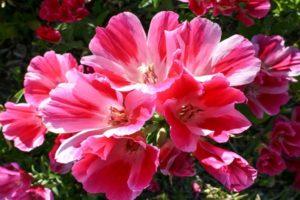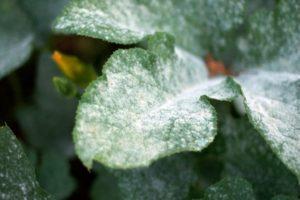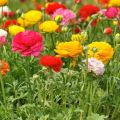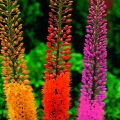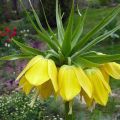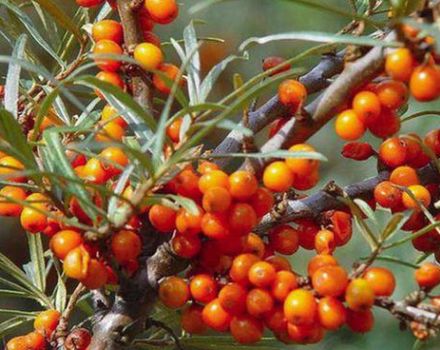Planting, growing and caring for brugmansia in the open field
To plant an exotic brugmansia plant and provide appropriate care, you need to know a few simple rules. Despite the fact that a guest from South America is accustomed to a hot and humid climate, even in the conditions of central Russia, you can enjoy its beautiful flowers. Indoor varieties will delight the owners and surprise guests all year round.
Description
Brugmansia is known primarily for its beautiful flowers that resemble giant gramophones hanging from the branches. Their colors are very diverse: depending on the variety, you can find white, yellow, red, all shades of pink and even multi-colored. Breeders creating all the new garden varieties have bred plants with double and multi-tiered flowers, similar to fancy ball gowns.
Popular varieties
In nature, brugmansia is a shrub or tree that grows up to five meters. However, for breeding at home, not such high varieties were bred, differing in the shape and shade of flowers and leaves. More than a hundred cultivated varieties are grown around the world, in Russia the following are the most popular.
Fragrant
Fragrant brugmansia (fragrant) pleases the eye with white or light green flowers up to 30 cm long, and up to 15 cm in diameter. The buds are pinkish.
Golden
Thanks to the yellow-orange flowers, the variety was named "golden". Large leaves grow up to 50 cm in length, they are soft to the touch.
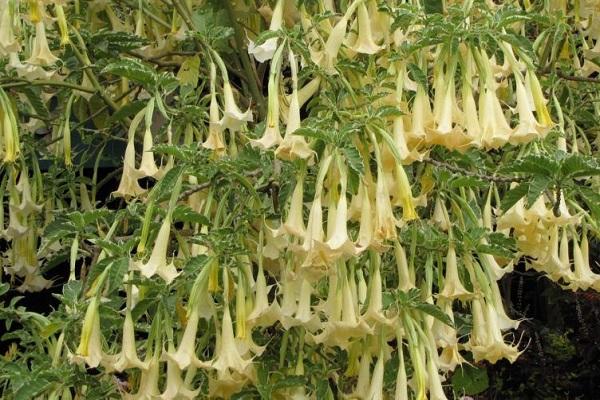
Snow-white
Initially, the flowers were white, which gave the name to the variety, but on its basis varieties with yellow and apricot colors were bred. It is a low tree, for which it also has a second name - woody. The leaves are velvety to the touch, oval in shape.
Multicolored
This variety of brugmansia is called multi-colored for its unusual color of flowers, which with age can change from white to peach or apricot. Gramophone grows longer than 50 cm, which makes them the largest among the plants of this genus.
Blood red
Blood-red brugmansia comes from Brazil. The tree grows up to one and a half meters. During flowering, it is covered with flowers up to 30 cm long, painted in red and white stripes on the tube and in yellow-green shades at the base.
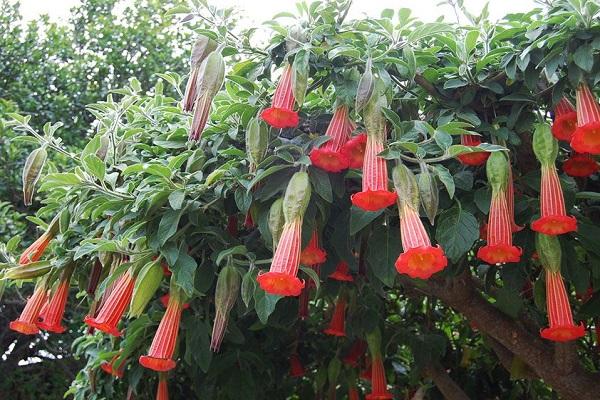
Variegated
The variety differs from others in the color of the leaves: they are green, covered with silvery spots, along the edge there is a white-yellow border. The flowers are large, white or creamy.
Tree-like
Brugmansia tree-like came to us from Brazil and became the ancestor of many varieties with a wide variety of flower colors. The flower bells, in comparison with other plants of this genus, are relatively small, up to 12 cm long.
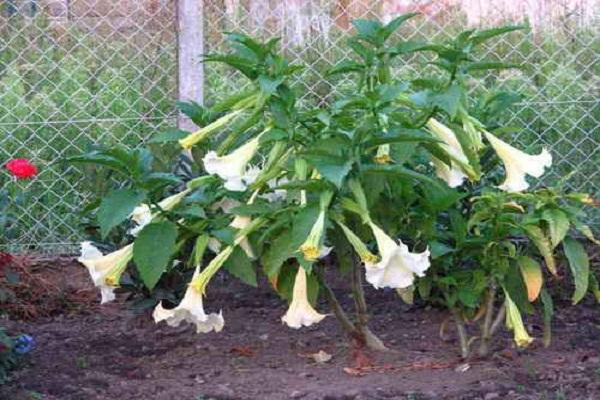
Features of growing in the open field
The subtropical origin of brugmansia makes it unacceptable for her to winter in her backyard in a frosty climate. Temperatures below +5 will destroy the tree. In Russia, the plant is bred outdoors only in the south, for example, in the Crimea.
If the climatic conditions are unfavorable, the potted plant is removed indoors for the winter, and in the warm season the tub with brugmansia is taken out into the garden. If the temperature permits, perennials are added to the open ground for the summer, and closer to autumn frosts they are again transplanted into a tub and taken to a room for wintering. To make the transplanting process easier, the plant is grown in a container with holes, transplanted with it.
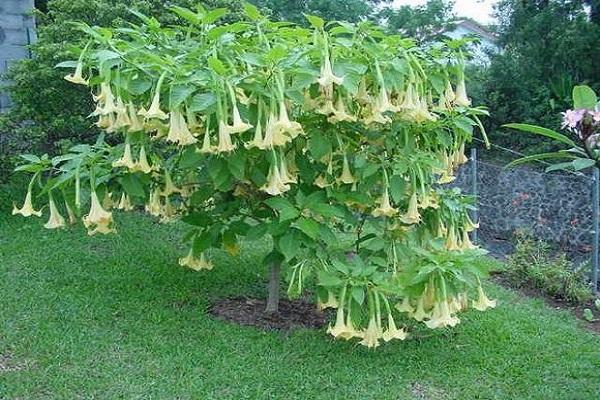
Seat selection
In order for brugmansia to feel good and to please with abundant flowering, it is necessary to provide it with conditions as close as possible to the subtropics and tropics, where the plant comes from. This means that sufficient lighting and humidity is required. The tree does not like the wind, since drafts create windage due to the size of flowers and leaves.
Soil preparation
The ideal soil for brugmansy is fertile, loose, and neutral. In the place of future placement, a mixture of loam, humus and peat is prepared for the plant. The components are mixed well, loosened and disinfected with a weak solution of potassium permanganate.
Watering
The tree naturally grows in the humid tropics, so it is important to provide it with sufficient water. The plant requires daily watering in the summer season, and on hot days it may need to moisten the soil twice a day, it all depends on the condition of the soil. But stagnation of water must also not be allowed, it is no less dangerous than drought.
In addition to watering, frequent spraying is necessary. During the flowering period, you must carefully monitor so that moisture does not get on the flowers. It is best to spray late in the evening.

Top dressing
The tree is fed regularly: starting in spring and throughout the warm season, complex fertilizers are applied every 7-10 days, pouring water over the brugmansia with additional fertilizing added to it. You can feed the plant with organic matter, for example, a solution of a mullein with water in a ratio of 1:10. Blooming brugmansia is deficient in phosphorus and potassium.
Pruning
In order for brugmansia to please with luxurious flowering, it is required to regularly cut off shoots, forming a crown.
When to conduct
Sanitary pruning of brugmansia is carried out before the beginning of the active growth phase, as a rule, this time falls at the end of February - beginning of March. Autumn pruning is done to prepare the plant for wintering.
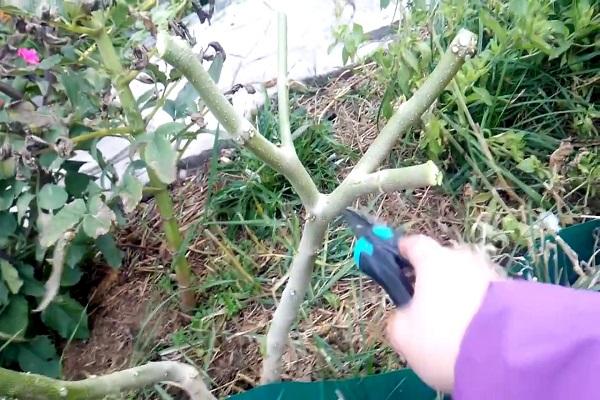
Scheme
First of all, you need to determine on which branches the flowers will appear, so as not to accidentally cut them off.
- First, the flowering part of the plant differs from the non-flowering leaves. In the flowering zone at the base of the leaf plate there is a ledge, in the area without flowers symmetrical whole leaves grow.
- Secondly, the buds grow on shoots that resemble the letter Y. Such branches are not cut off, only the tops of non-flowering buds are shortened by no more than three buds.
- In addition, a standard shrub pruning of dry, damaged, too long, thickening non-flowering shoots is carried out.
How often
Pruning is carried out annually in early spring, if it is necessary to prepare the plant for wintering - in the fall. In summer, thinning and pruning of the crown is not required, unless the gardener wants to give it some interesting shape.
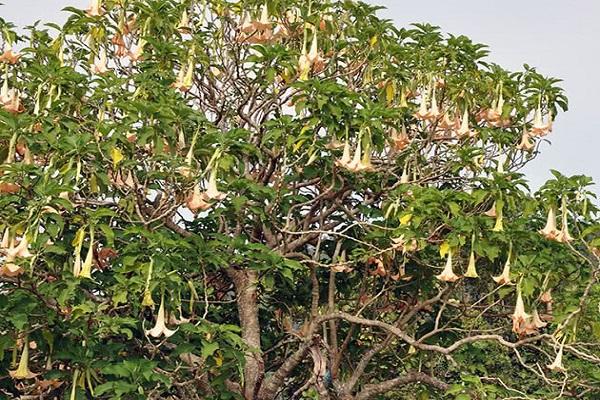
Reproduction
Brugmansia is propagated by cuttings, layering and seeds. The most popular is cuttings, the material can be prepared by yourself or purchased in the store.
Cuttings
Most gardeners prefer to cut the shrub because it is the easiest and most reliable way to do it. Cuttings are harvested in September or in March, for which the shoots are cut from the top of the plant about 20 cm long. The lower leaves are cut off, the upper ones are cut in half.
You can root the cuttings in water or directly in the substrate. After the formation of a sufficient number of roots, the cutting is transplanted to a permanent place, be it a tub or open ground.
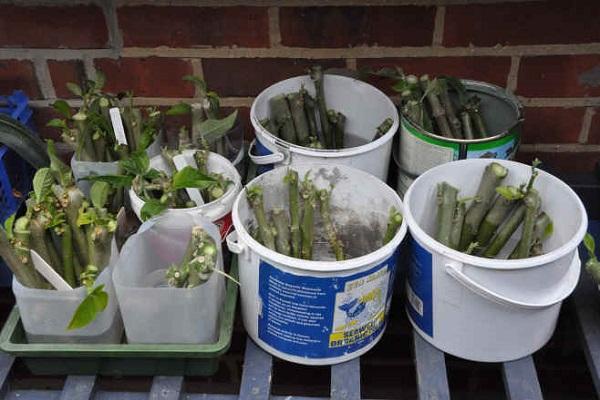
Layers
To propagate brugmansia with air layers, you must choose last year's shoot at the top of the bush. A wedge-shaped cross section is made on it, sphagnum moss is applied, and wrapped with a film on top. After the formation of roots, after a month and a half, the shoot is cut off and planted in a pot, placed in a shaded place and sprayed daily.
Seeds
When brugmansia is propagated by seeds, heredity is not preserved, therefore, a sprout of a completely different variety may appear. The seeds of the plant are sown at the end of winter to a depth of 2 cm, covered with foil, and maintained warm and humid in bright light. After 2 weeks, shoots can be expected, and after the appearance of the fifth leaflet, the plant is transplanted into a temporary pot. After the root system of the flower grows over the entire substrate, the seedling is moved to a permanent place.
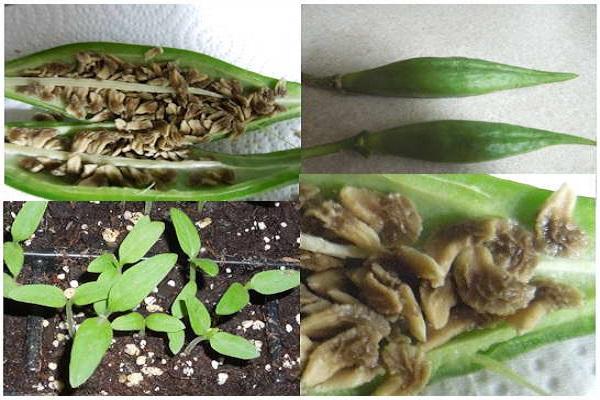
Subtleties of winter care
In the southern regions, the plant hibernates in the open field. In more northern latitudes, the flower hibernates indoors in a pot, and in the summer the plant is planted in open ground or taken out into the garden directly in a tub. Wintering brugmansia indoors is possible in several ways:
- Blooming in winter. In order for the plant to bloom all year round, the pot is placed in a warm room and a long daylight hours are maintained by means of artificial lighting.
- Half-dead. The tub with brugmansia is placed in a bright room with a temperature of up to +15, periodically watered.
- Peace. Wintering a flower in a dark cool room. They maintain the temperature up to +5, by means of watering they only maintain soil moisture.
- Wintering with a handle. If it is not possible to provide conditions for the wintering of a whole perennial, you can prepare a cutting from a flowering bush in the summer. To do this, cut off a part of the shoot with an apical bud, root it and get a young flowering plant next spring.

Diseases and pests
Both when grown in the open field and when planted in a pot at home, Brugmansia is not immune from damage by diseases and pests. On the street, the flower is often attacked by parasites that eat the foliage; fungal diseases can develop indoors. Timely treatment with special preparations will help keep the plant healthy.
Spider mite
If, in hot and dry weather, light dots appear on the leaves of a perennial, developing into large colorless areas, and a cobweb on the underside, this is a defeat of brugmansia by a spider mite. Fitoverm, Aktara and humidity increase copes well with it.
Aphid
A colony of insects can be determined visually, the first signs of their appearance on a plant are twisted tops of shoots and a sticky coating on the leaves. They fight the pest by washing the greens with soapy water and spraying with tobacco dust.
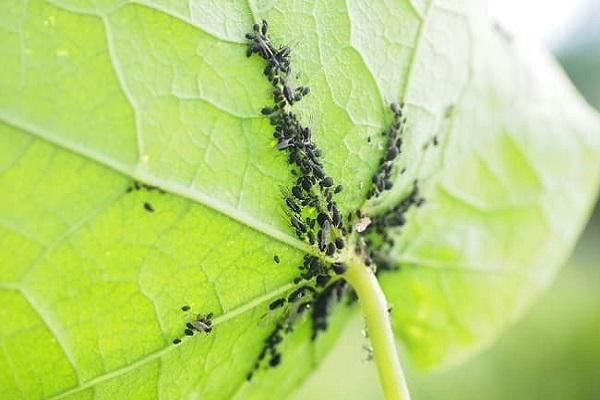
Viral diseases
The defeat of viruses leads to the cessation of the growth of brugmansia. At the first signs, which can be expressed in the appearance of foreign colored areas on greenery, deformation, twisting, the plant is isolated and destroyed in order to prevent infection of the neighboring ones.
Nitrogen starvation
Signs of nitrogen starvation are yellowing and shedding of greenery.To combat the disease, it is necessary to feed the plant with a nitrogen-containing fertilizer.

How to grow at home
To grow brugmansia at home, you need to provide it with warmth and sufficient humidity. Care should be taken when choosing a place for the plant, as the strong scent can cause headaches.
Soil selection
The soil for the plant needs fertile and moist, but lightweight. A mixture of humus, vermicompost, clay soil in 1 part and 2 parts of peat is well suited. The mixture is well loosened, moistened and disinfected in any way before planting.
Transfer
Brugmansia is transplanted every year, increasing the size of the pot as the plant's root system grows. The perennial should be dug out carefully so as not to damage the roots, the whole earthen ball should be placed in a plastic pot with drainage holes.
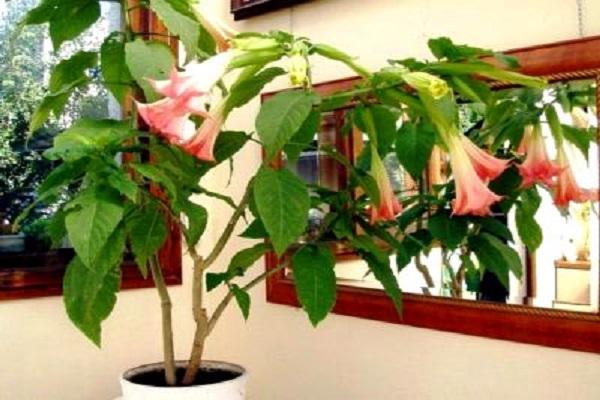
Prevention
To keep the plant healthy, you need to perform simple preventive measures:
- When watering, avoid getting water on leaves and flowers.
- Regular airing or taking out the tub with the plant to fresh air will help against spider mites, which like stagnant air.
- The addition of crushed charcoal to the soil will prevent the appearance of fungal infections and putrefactive bacteria.
- As a prophylaxis of fungal diseases, the flower can be treated with fungicidal preparations.
- Insecticide treatment for the prevention of pest damage.
Answers on questions
The most frequent question asked by novice growers is why the plant does not bloom. The reason may be a lack of light or other violations of the rules for the care and maintenance of a perennial. If this is a delay in the onset of flowering after a period of winter dormancy or semi-dormancy with the onset of spring, then it may have occurred as a result of violations of wintering conditions. If you store the plant in compliance with the temperature and light conditions, then even hibernating in an apartment, in the summer it will delight you with bright and beautiful flowers.
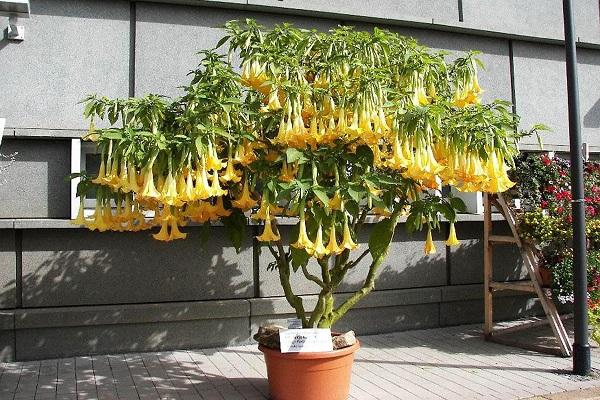
Reviews
Gardeners who have tried to grow brugmansia are captivated by the beauty of the plant and the variety of species. Groups are created on social networks, flower growers from different cities exchange tips on growing and cuttings.
Alina, 34 years old: “I was faced with a spider mite defeat. It's good that I noticed it in time. I treated it twice with Aktellik and the insects disappeared. "
Basically, the reviews are positive, despite some difficulties in growing a perennial, flower growers recommend it for planting on a site or at home.
Although the origin of brugmansia is exotic, the plant takes root well in our latitudes. You can enjoy the beautiful flowers of a perennial by planting it in a tub at home or placing it on your personal plot. If you provide the tree with the necessary care, it will give a real aesthetic pleasure.
